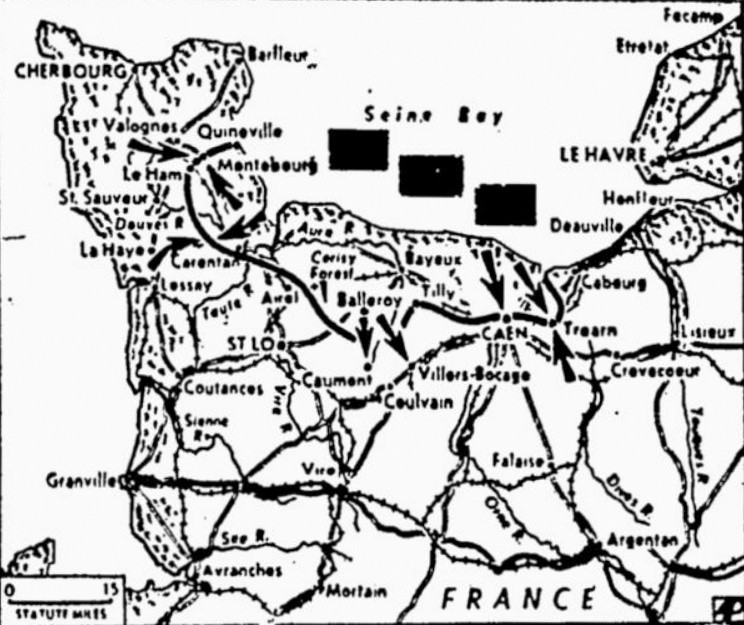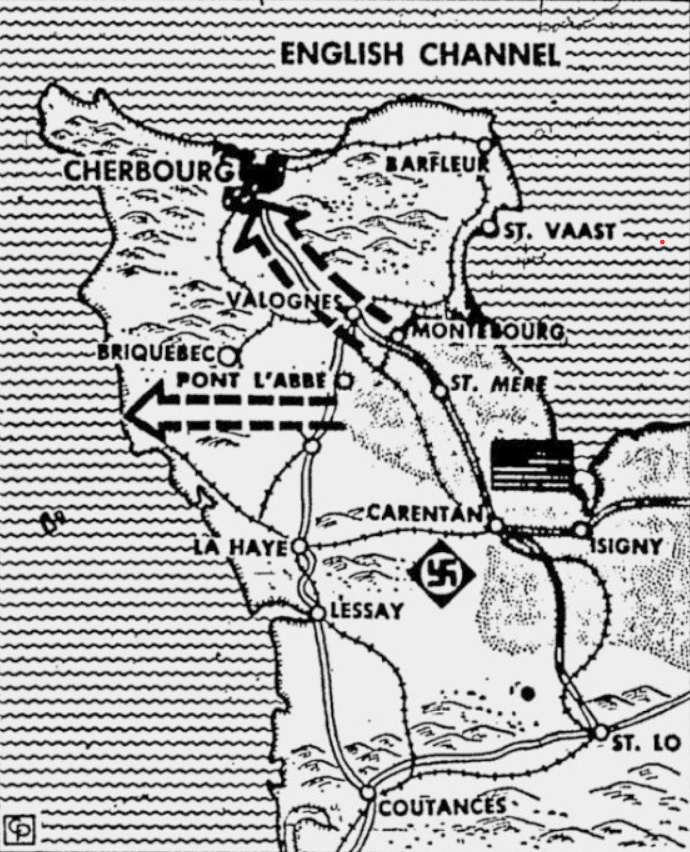Innsbrucker Nachrichten (June 15, 1944)
Schlacht in der Normandie vor dem Höhepunkt
Die deutschen Truppen behaupteten ihre Stellungen – In zehn Tagen 400 Panzer und über tausend Flugzeuge vernichtet, 13 Kriegsschiffe und 23 Fracht- und Transportschiffe versenkt
dnb. Aus dem Führer-Hauptquartier, 15. Juni –
Das Oberkommando der Wehrmacht gibt bekannt:
Die Schlacht in der Normandie steigert sich von Tag zu Tag in ihrer Heftigkeit. Nachdem es dem Feind in den ersten Tagen der Invasion darauf angekommen war, an der Küste festen Fuß zu fassen, versucht er nun, nach allen Seiten seinen Brückenkopf zu erweitern. Unter den Salven schwerster Schiffsgeschütze, laufenden Luftangriffen und unter dem Einsatz neu herangeführter Infanterie- und Panzerkräfte auf beiden Seiten strebt die Schlacht ihrem Höhepunkt zu.
Am gestrigen Tage entwickelten sich besonders im Raum um Tilly, Caumont und südwestlich Balleroy heftige Kämpfe, in deren Verlauf zahlreiche feindliche Panzer abgeschossen wurden. Der Feind hatte besonders schwere blutige Verluste. Unsere Truppen behaupteten überall ihre Stellungen. Östlich Caumont nahmen eigene Panzerverbände mehrere zäh verteidigte Ortschaften. Feindliche Fallschirmjäger, die nordöstlich Saint-Lô hinter unserer Front abgesprungen waren, wurden vernichtet. Nur im Raum westlich und nördlich Sainte-Mère-Église konnte der Feind geringe Geländegewinne erzielen.
In der vergangenen Nacht wurden durch Angriffe starker Kampffliegerverbände 14 Transportschiffe mit 101.000 BRT und zwei Zerstörer durch Bomben- und Torpedotreffer entweder versenkt oder schwer beschädigt. Hiebei zeichnete sich eine Kampffliegergruppe unter Major Thomsen besonders aus.
Im Verlauf eines harten Nachtgefechtes unserer Minenräumboote mit einem von fünf Zerstörer gesicherten feindlichen Kreuzerverband südwestlich der Insel Jersey wurde ein Zerstörer in Brand geschossen. Ein eigenes Boot ging dabei verloren.
Heeresküstenbatterien beschossen vor der Ornemündung einen von einem schweren Kreuzer und Zerstörern gesicherten Landungsverband und beschädigten den Kreuzer sowie einen Zerstörer. Der Verband wurde zerstreut. Vor der Nordwestküste der Halbinsel Cherbourg erzielten unsere Küstenbatterien auf weiteren Schiffen Treffer. Zerstörergruppen und Schnellboote wurden zum Abdrehen gezwungen.
Die Härte der Kämpfe und die beispielhafte Haltung unserer Truppen aller Wehrmachtteile zeigt sich in den bis jetzt erzielten Erfolgszahlen. In den ersten zehn Tagen des feindlichen Invasionsangriffes haben unsere Truppen über 400 feindliche Panzer und über 1.000 Flugzeuge vernichtet. Nicht eingerechnet sind die zahlreichen Panzer, Geschütze und schweren Waffen aller Art, die bei Angriffen von Einheiten der Kriegsmarine und der Luftwaffe gegen die feindliche Landungsflotte untergingen.
Insgesamt versenkten Luftwaffe, Kriegsmarine sowie Heeres- und Marineküstenbatterien seit Beginn der Invasion zwei Kreuzer, neun Zerstörer, zwei Schnellboote, 23 Fracht- und Transportschiffe mit 131.400 BRT. sowie 12 Panzerlandungsschiffe mit 18.300 BRT. Außerdem wurden durch Torpedo-, Bomben- und Artillerietreffer zwei schwere Kreuzer, drei weitere Kreuzer, 16 Zerstörer, 8 Schnellboote, 58 Handels- und Transportschiffe mit 235.000 BRT, 2 Landungsfahrzeuge mit 4000 BRT und ein Dampfer mittlerer Größe schwer beschädigt. Die Verluste des Feindes an Kriegs- und Landungsschiffen durch Minentreffer erhöhen diese Zahlen wesentlich.
Die blutigen Verluste des Feindes, insbesondere an seinen Eliteverbänden, den Luftlandedivisionen, betragen ein Vielfaches unserer eigenen.
An der italienischen Front hält der starke feindliche Druck beiderseits des Bolsenasees unvermindert an. Unsere schwer ringenden Truppen leisteten auch gestern dem Feind erbitterten Widerstand, konnten jedoch schließlich nicht verhindern, daß der Feind nach Norden Boden gewann. Erneute feindliche Angriffe nördlich und nordwestlich des Sees wurden abgewiesen. Die Kämpfe gehen weiter.
Aus dem Osten werden keine besonderen Ereignisse gemeldet. Im hohen Norden wurden im Louhi- und Kandalakscha-Abschnitt mehrere starke Vorstöße der Bolschewisten abgewiesen. Unterseeboote versenkten im Schwarzen Meer zwei sowjetische Kanonenboote und einen Seeschlepper.
Nordamerikanische Bomberverbände griffen gestern das Stadtgebiet von Budapest an. Durch ungarische und deutsche Luftverteidigungskräfte wurden 18 feindliche Flugzeuge abgeschossen. Einzelne britische Flugzeuge warfen in der vergangenen Nacht Bomben im rheinisch-westfälischen Raum. Deutsche Kampfflugzeuge griffen Einzelziele in Südostengland an.

